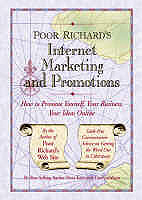Poor Richard’s Internet Marketing and Promotions, Peter Kent and Tara Calishain Top Floor Publishing, 1999, ISBN 0966103270
Reviewed by Jean Hollis Weber
 This book is subtitled “How to Promote Yourself, Your Business, Your Ideas Online: Geek-Free Commonsense Advice on Getting the Word Out in Cyberspace.”
This book is subtitled “How to Promote Yourself, Your Business, Your Ideas Online: Geek-Free Commonsense Advice on Getting the Word Out in Cyberspace.”
I gave Peter Kent’s first book in this series, “Poor Richard’s Web Site: Geek-Free, Commonsense Advice on Building a Low-Cost Web Site,” full marks on value for money. I found that book very helpful when choosing my current Web hosting company, getting my own domain name, and setting up my site; then I returned to it for more ideas when starting The Technical Editors’ Eyrie. The book had far more information than I was able to digest and put to use at the time, particularly on the subject of marketing and promotion.
Then, by one of those wonderful coincidences, just as I was increasing my marketing and launching my e-mail newsletter, along comes “Poor Richard’s Internet Marketing and Promotions.” This book elaborates on topics covered in Part III of the first book, and adds a lot of new material and new sources of information and assistance.
Like the first book, this one starts off by asking readers to think about their purpose and their market: what do you want to happen? who are you aiming at? It looks briefly at some good and bad points about promoting one’s site, products and services on the Web, then summarizes what you need in the way of hardware and software. I find this useful when talking to clients and others who know they want to be online, but really haven’t a clue what’s involved. More knowledgeable readers may feel they know all the basics, but I managed to find an idea or two here that was new to me. Chapter 3 launches into a discussion of Web site basics: choosing where to put your site, domain names, shopping cart software and online transactions, and so on.
I am highly critical of many sites’ design, which gets in the way of what I want to do at the site: either I can’t find what I’m looking for easily, or the graphics take far too long to download, or the typesize is too small for me to read (and enlarging it often causes the page to go completely goofy, if enlargement works at all) — or all three! So I was quite enthusiastic to read this section, at the end of Chapter 3:
“Web Design — It’s Software, Not Graphic Design
“How do you go about designing a Web site? We believe you should remember that a Web site is a piece of software. Few site owners seem to understand this, and even fewer Web designers do. Web design has become the domain of the graphic designer, which is a big mistake. Consequently there are many thousands of great looking Web sites … that load slowly and are difficult to move around in.
“A Web site is a piece of software. It has to do something. Unlike a piece of graphic design — a billboard or magazine ad, for instance — a Web site is interactive. People click on links and buttons to make the site actually do something. So the primary concern should be user-interface design. Does the Web site actually work properly? Does it achieve its aims?
“Once you have a Web site that works, you can make it look good. You shouldn’t work the other way around.”
In Chapter 5, the authors discuss “Seven steps to Web-site readiness,” including spell-check it, proofread it, get someone else to proofread it, check your links, and make sure your site can be navigated without graphics, Java, or Javascript — things that a lot of “designers” pay little attention to.
Other chapters look at where to promote a site, where and how to register a site (and what to do to assist robots indexing the site), where and how to get assurances, awards and alliances (most of which were new to me), promoting through newsgroups and mailing lists (what to do and, possibly more importantly for many people, what not to do), creating your own newsletter and discussion group, various forms of advertising, affiliate programs, tracking results, using e-mail for promotions (without spamming), reaching journalists, using press releases, and a bit on real-world promotions and sales basics. If it hasn’t been mentioned in here, at least in passing, it’s probably not worth worrying about.
So what does all this have to do with technical writing and editing? A lot — if you’re looking for new ways to promote yourself and your services. Kent and Calishain help you ask yourself some important questions, then go on to lead you toward the answers that are right for you — meanwhile pointing out some of the traps to avoid along the way. I highly recommend this book, and the earlier one. (And a forthcoming one, which I’ve been fortunate to read in a pre-release copy: “Poor Richard’s E-Mail Publishing.” Look for that one later this year.)
Although some of the how-to details in the book are a bit dated (for example, today one would be more likely to publish a blog than a newsletter), the principles are still valid and important. You can order the book from resellers at Amazon.com.
Last updated 1 October 2007.
